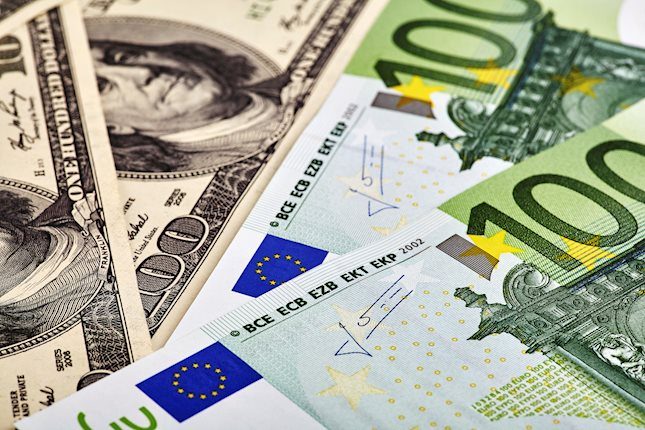- EUR/USD trades above 1.0700 in the European session on Thursday.
- 1.0730 aligns as first resistance for the pair.
- US GDP data will be watched closely by market participants later in the day.
EUR/USD gained traction and climbed to its highest level in over 10 days above 1.0720 early Thursday. The pair's technical outlook suggests that the pair has more room on the upside before turning overbought in the near term.
Euro price this week
The table below shows the percentage change of Euro (EUR) against listed major currencies this week. Euro was the strongest against the Japanese Yen.
| USD | EUR | GBP | CAD | AUD | JPY | NZD | CHF | |
| USD | -0.60% | -1.04% | -0.45% | -1.53% | 0.64% | -0.98% | 0.27% | |
| EUR | 0.58% | -0.45% | 0.14% | -0.92% | 1.22% | -0.38% | 0.83% | |
| GBP | 1.04% | 0.45% | 0.58% | -0.47% | 1.67% | 0.07% | 1.27% | |
| CAD | 0.44% | -0.15% | -0.60% | -1.08% | 1.08% | -0.53% | 0.69% | |
| AUD | 1.50% | 0.92% | 0.48% | 1.06% | 2.12% | 0.54% | 1.78% | |
| JPY | -0.63% | -1.23% | -1.68% | -1.08% | -2.16% | -1.61% | -0.36% | |
| NZD | 0.97% | 0.38% | -0.07% | 0.53% | -0.54% | 1.59% | 1.23% | |
| CHF | -0.24% | -0.84% | -1.30% | -0.69% | -1.77% | 0.39% | -1.21% |
The heat map shows percentage changes of major currencies against each other. The base currency is picked from the left column, while the quote currency is picked from the top row. For example, if you pick the Euro from the left column and move along the horizontal line to the Japanese Yen, the percentage change displayed in the box will represent EUR (base)/JPY (quote).
The renewed selling pressure surrounding the US Dollar (USD) helps EUR/USD hold its ground in the European trading hours. Although US stock index futures trade deep in negative territory, the USD struggles to find demand.
The Nasdaq Futures were last seen losing more than 1% on the day. This, however, seems to be a product of the sharp decline seen in technology shares following disappointing earnings reports, rather than a general risk aversion.
Later in the day, the US Bureau of Economic Analysis will release its first estimate of the annualized real Gross Domestic Product (GDP) growth for the first quarter. Investors expect the US economy to grow 2.5% following the 3.4% expansion recorded in the last quarter of 2023.
In case the data shows that the US economy grew at a softer pace than forecast in Q1, the initial reaction could cause the USD to continue to weaken against its rivals. On the other hand, a GDP reading at or above the market expectation could support the USD and weigh on EUR/USD.
EUR/USD Technical Analysis
The Relative Strength Index (RSI) indicator on the 4-hour chart is yet to climb above 70, suggesting that EUR/USD has more room on the upside before it turns technically overbought.
The 100-period Simple Moving Average (SMA) aligns as immediate resistance at 1.0730 before 1.0750 (Fibonacci 38.2% retracement of the latest downtrend). In case EUR/USD manages to clear the latter, it could target 1.0790 (200-period SMA, Fibonacci 50% retracement) next.
On the downside, 1.0700 (Fibonacci 23.6% retracement) could be seen as first support before 1.0660 (50-period SMA) and 1.0635 (static level).
Euro FAQs
The Euro is the currency for the 20 European Union countries that belong to the Eurozone. It is the second most heavily traded currency in the world behind the US Dollar. In 2022, it accounted for 31% of all foreign exchange transactions, with an average daily turnover of over $2.2 trillion a day. EUR/USD is the most heavily traded currency pair in the world, accounting for an estimated 30% off all transactions, followed by EUR/JPY (4%), EUR/GBP (3%) and EUR/AUD (2%).
The European Central Bank (ECB) in Frankfurt, Germany, is the reserve bank for the Eurozone. The ECB sets interest rates and manages monetary policy. The ECB’s primary mandate is to maintain price stability, which means either controlling inflation or stimulating growth. Its primary tool is the raising or lowering of interest rates. Relatively high interest rates – or the expectation of higher rates – will usually benefit the Euro and vice versa. The ECB Governing Council makes monetary policy decisions at meetings held eight times a year. Decisions are made by heads of the Eurozone national banks and six permanent members, including the President of the ECB, Christine Lagarde.
Eurozone inflation data, measured by the Harmonized Index of Consumer Prices (HICP), is an important econometric for the Euro. If inflation rises more than expected, especially if above the ECB’s 2% target, it obliges the ECB to raise interest rates to bring it back under control. Relatively high interest rates compared to its counterparts will usually benefit the Euro, as it makes the region more attractive as a place for global investors to park their money.
Data releases gauge the health of the economy and can impact on the Euro. Indicators such as GDP, Manufacturing and Services PMIs, employment, and consumer sentiment surveys can all influence the direction of the single currency. A strong economy is good for the Euro. Not only does it attract more foreign investment but it may encourage the ECB to put up interest rates, which will directly strengthen the Euro. Otherwise, if economic data is weak, the Euro is likely to fall. Economic data for the four largest economies in the euro area (Germany, France, Italy and Spain) are especially significant, as they account for 75% of the Eurozone’s economy.
Another significant data release for the Euro is the Trade Balance. This indicator measures the difference between what a country earns from its exports and what it spends on imports over a given period. If a country produces highly sought after exports then its currency will gain in value purely from the extra demand created from foreign buyers seeking to purchase these goods. Therefore, a positive net Trade Balance strengthens a currency and vice versa for a negative balance.
Information on these pages contains forward-looking statements that involve risks and uncertainties. Markets and instruments profiled on this page are for informational purposes only and should not in any way come across as a recommendation to buy or sell in these assets. You should do your own thorough research before making any investment decisions. FXStreet does not in any way guarantee that this information is free from mistakes, errors, or material misstatements. It also does not guarantee that this information is of a timely nature. Investing in Open Markets involves a great deal of risk, including the loss of all or a portion of your investment, as well as emotional distress. All risks, losses and costs associated with investing, including total loss of principal, are your responsibility. The views and opinions expressed in this article are those of the authors and do not necessarily reflect the official policy or position of FXStreet nor its advertisers. The author will not be held responsible for information that is found at the end of links posted on this page.
If not otherwise explicitly mentioned in the body of the article, at the time of writing, the author has no position in any stock mentioned in this article and no business relationship with any company mentioned. The author has not received compensation for writing this article, other than from FXStreet.
FXStreet and the author do not provide personalized recommendations. The author makes no representations as to the accuracy, completeness, or suitability of this information. FXStreet and the author will not be liable for any errors, omissions or any losses, injuries or damages arising from this information and its display or use. Errors and omissions excepted.
The author and FXStreet are not registered investment advisors and nothing in this article is intended to be investment advice.
Recommended Content
Editors’ Picks

GBP/USD: The bearish outlook remains in play below 1.2700
The GBP/USD pair edges lower to near 1.2675, the lowest level since August during the Asian trading hours on Friday. The cautious remarks from the Federal Reserve Chair Jerome Powell on Thursday and stronger US economic data boost the US Dollar broadly and weigh on the major pair.

EUR/USD rises to near 1.0550 after rebounding from yearly lows
EUR/USD breaks its five-day losing streak, trading around 1.0540 during the Asian session on Friday. This rebound is likely due to a downward correction in the US Dollar following comments from Fed Chair Jerome Powell.

Gold defends key $2,545 support; what’s next?
Gold price is looking to build on the previous rebound early Friday in search of a fresh impetus amid persistent US Dollar buying and mixed activity data from China.

Bitcoin to 100k or pullback to 78k?
Bitcoin and Ethereum showed a modest recovery on Friday following Thursday's downturn, yet momentum indicators suggest continuing the decline as signs of bull exhaustion emerge. Ripple is approaching a key resistance level, with a potential rejection likely leading to a decline ahead.

Trump vs CPI
US CPI for October was exactly in line with expectations. The headline rate of CPI rose to 2.6% YoY from 2.4% YoY in September. The core rate remained steady at 3.3%. The detail of the report shows that the shelter index rose by 0.4% on the month, which accounted for 50% of the increase in all items on a monthly basis.

Best Forex Brokers with Low Spreads
VERIFIED Low spreads are crucial for reducing trading costs. Explore top Forex brokers offering competitive spreads and high leverage. Compare options for EUR/USD, GBP/USD, USD/JPY, and Gold.
